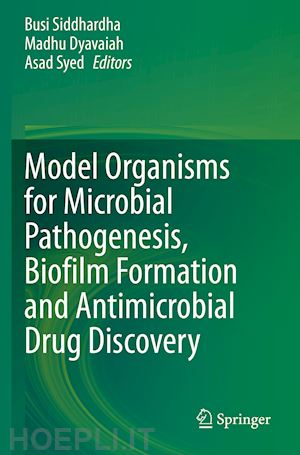
Questo prodotto usufruisce delle SPEDIZIONI GRATIS
selezionando l'opzione Corriere Veloce in fase di ordine.
Pagabile anche con Carta della cultura giovani e del merito, 18App Bonus Cultura e Carta del Docente
This book provides essential insights into microbial pathogenesis, host-pathogen interactions, and the anti-microbial drug resistance of various human pathogens on the basis of various model organisms.
The initial sections of the book introduce readers to the mechanisms of microbial pathogenesis, host-pathogen interactions, anti-microbial drug resistance, and the dynamics of biofilm formation. Due to the emergence of various microbial resistant strains, it is especially important to understand the prognosis for microbial infections, disease progression profiles, and mechanisms of resistance to antibiotic therapy in order to develop novel therapeutic strategies.
In turn, the second part of the book presents a comparative analysis of various animal models to help readers understand microbial pathogenesis, host-pathogen interactions, anti-microbial drug discovery, anti-biofilm therapeutics, and treatment regimes. Given its scope, the book represents a valuable asset for microbiologists, biotechnologists, medical professionals, drug development researchers, and pharmacologists alike.
Dr. Busi Siddhardha is an Assistant Professor at the Department of Microbiology, Pondicherry University, India. He received his Ph.D. from the Biology Division, CSIR-IICT, Hyderabad. He has worked extensively in the field of nanotechnology, and on the applications of nanotechnology in drug discovery, drug delivery, sustained release and photodynamic therapy. His current research focuses on bacterial quorum sensing, biofilms, antimicrobial photodynamic therapy and nanobiotechnology. He serves on the editorial boards of various respected journals, has published more than 60 research articles in peer-reviewed international journals, and has authored or co-authored numerous book chapters. He is a member of several national and international scientific societies.
Dr. Madhu Dyavaiah is an Assistant Professor at the Department of Biochemistry and Molecular Biology, Pondicherry University, India. He has previously served as a Research Scientist at the College of Nanoscale Science and Engineering, Albany, USA (2010-2012), Postdoctoral Associate at Gen’NY’sis Center for Excellence in Cancer Genomics, Rensselaer, USA (2006-2010), and Postdoctoral Fellow at the Wadsworth Center, New York Dept. of Health, USA (2003-2006). His research interests include molecular pathogenesis, DNA damage response, tRNA modification and translation regulation, and the biology of aging. Currently, he is working with different model systems such as S. cerevisiae and mice models to study the effects of natural compounds on microbial pathogens, neurodegenerative diseases and cancer. He has received various prestigious awards and is a member of many scientific societies and organizations. He has served as a reviewer for a number of international journals, published more than 20 research articles in peer-reviewed international journals, and authored three book chapters.
Dr. Asad Syed is an Assistant Professor at the Botany and Microbiology Department, College of Science, King Saud University, Riyadh, Saudi Arabia. He completed his Ph.D. at the University of Pune, India, and subsequently worked at CSIR National Chemical Laboratory in Pune, where he served as a Research Associate and Senior Research Fellow in the Biochemical Sciences Division. His research interests are in the fabrication of nanomaterials utilizing microorganisms including fungi, bacteria, and plant extracts. He is currently serving as a reviewer for a number of international journals and has published his research in various peer-reviewed international journals on materials science and microbiology.











Il sito utilizza cookie ed altri strumenti di tracciamento che raccolgono informazioni dal dispositivo dell’utente. Oltre ai cookie tecnici ed analitici aggregati, strettamente necessari per il funzionamento di questo sito web, previo consenso dell’utente possono essere installati cookie di profilazione e marketing e cookie dei social media. Cliccando su “Accetto tutti i cookie” saranno attivate tutte le categorie di cookie. Per accettare solo deterninate categorie di cookie, cliccare invece su “Impostazioni cookie”. Chiudendo il banner o continuando a navigare saranno installati solo cookie tecnici. Per maggiori dettagli, consultare la Cookie Policy.